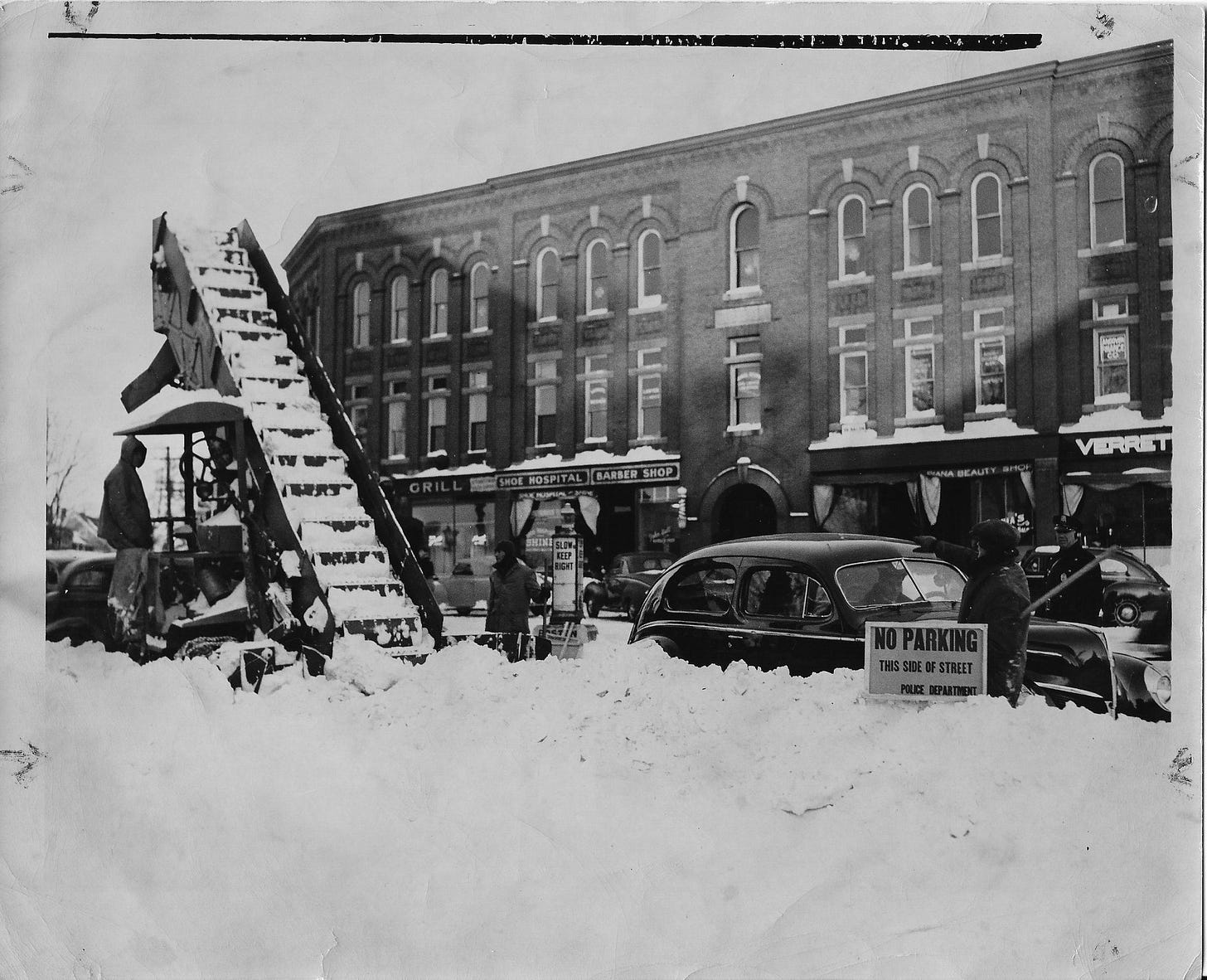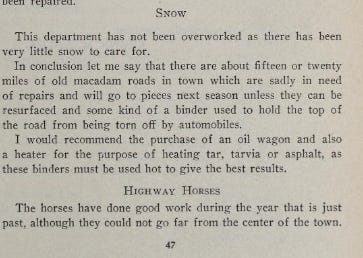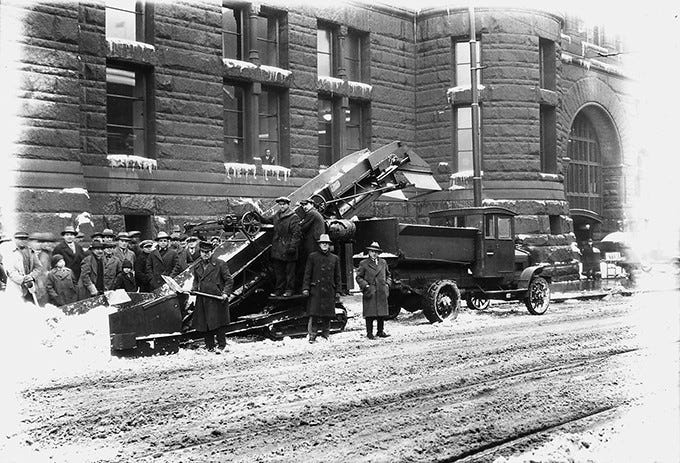What’s It Wednesday: The latest in snow removal technology
The automobile changed the way cities dealt with roads and snow.
Welcome or welcome back to History Buzz! If you’re a subscriber to the Buzz, thank you! If you’re new here, or you haven’t become a subscriber yet, please sign up for a subscription to have History Buzz delivered directly to your inbox.
I came across this photo in the History Center’s collection and became intrigued by the description of “a snow ladder.”

We know the photo was taken in the 1940s based on the businesses that are in the Musgrove Building (2 Elm Square) behind the snow removal. To the far right is the sign for Verrette’s, which was in this location between 1919 and the 1940s. The eatery became the Ernie Verrett Restaurant in 1948. The Diana Beauty Salon was in the Musgrove Building in the 40s, along with Tony D’Amore’s Shoe Clinic.1
So, we know the photo is from the late 1940s, but what’s the story behind the snow ladder? That’s “the rest of the story!”
Automobiles changed the way cities dealt with roads and snow
Starting in the early 1910s, the need to clear roads for cars rose in importance. Andover Town Reports2 provide a glimpse into how the automobile changed the role of the Board of Public Works, later the Department of Public Works.
Prior to 1910, the primary concern of the Board of Public Works was water, sewer, and construction of roads and sidewalks. “City” roads were being laid with macadam (aka asphalt). Rural roads were laid with gravel and oil.
Snow removal is mentioned in Town Reports, usually along with a report on snowfall. Expenses for snow removal (then and now!) is related to the amount of snow that fell in any given year. Most of the expenses through the early 20th century were for labor, recorded in the Town Report via long lists of names and amounts paid to men to shovel and clear streets.
The 1911 Town Report listed expenses for labor, plus snow plows and a steam boiler under the snow removal budget report.
Horses still played a major role in snow removal, and the line item for “Hay, grain, and straw” continued all the way through 1939.
Throughout the 1920s, as automobile traffic increased, the Board of Public Works snow removal budget changed. Tractors were used to clear snow. In 1925, the Highways and Parks report reported on the amount of snow that fell that year. . . a total of 34.25 inches.
The cleaning of streets and patching of roads followed. This work is increasing at such a rate in the near future to do it efficiently a small truck and two or three men will be required at least six months of the year.
Throughout the 1930s, the town’s snow removal expenditure continued to include manual labor and teams of horses. By 1934, expenditures included $21,000 in labor costs plus another $9,400 for trucks for plowing and hauling snow and $6,300 for horses.
Significant to our story, 1937 was the first year that horses were not included in the Board of Public Works’ snow removal budget.
Snow removal technology moves ahead
By the mid 1920s, Andover was behind the times regarding snow removal. In 1920, the city of Chicago introduced a “snow loader,” which used a conveyor belt to lift snow up off the street and into a dump truck.
The Barber Green snow loader
Manufacturer of the snow loader, Barber Green, Ltd, was based in Aurora, Illinois. In the late 1910s, the company produced conveyor belts, loaders, and bucket loaders for coal. In 1920, they introduced their first snow loader. An auger/conveyor system that featured their tried-and-true bucket loader “crawler base.” The new machine was powered by a 4-cylinder gas engine that could load and move snow at an amazing 10 cubic yards per minute.3 Cities adopted the new technology long before small town like Andover.
Andover didn’t purchase its first snow loader until 1944. But the story actually began back in 1937.
A major snow storm had hit in 1935. At the height of the Great Depression, work to remove the snow was carried out by workers from the Federal Emergency Relief Administration out of Boston.
A Word of Praise
Much of the expense of the snow removal was absorbed by the E.R.A, which because of the emergency throughout the state transferred all outdoor workers to the task of clearing the streets. And a fine job these E.R.A. workers did. . . .it was a real source of pride to see that our E.R.A. workers were conscientiously doing their utmost.
Shoveling snow is far from being an easy task, as many of us found Thursday when we attempted to clear that little stretch of front walk. Nevertheless, these workers kept at it for eight hours a day, and the result was that by Saturday the business section of Main Street looked just as if an ordinary snowstorm had taken place. It is nice to know that in one town at least Uncle Sam’s money was not being squandered.
It was proved a might good advertisement for Andover. The praise has not been all local. The persons who appreciated it most were those who were passing through and who knew how intolerable the conditions were elsewhere.
The amount heavy work carried out by the Federally-funded E.R.A. workers - the benefits the town reaped - would factor heavily in 1937 discussions about whether to purchase a snow-loader for $8,500. The Andover Townsman reported on the debate in an editorial titled “Man vs Machine.”
At the recent round-table conference sponsored by the Taxpayer’s Association, the Board of Public Works mentioned that it had been considering the purchase of a snow-loader. . . There are two factors which must be taken into consideration in such a purchase . . . The first is that no one can count on the weather . . . In the very heavy storm two years ago seventy men were employed for three days at $4.92 per day, representing a cost of over $1,000. . . The greater part of the $1,000 labor charge would have been eliminated by the use of a snow-loader . . . But when you say that the $1,000 labor charge would almost be eliminated, you run into the second factor which makes the Board of Public works hesitate. When that big storm took place, there was considerable unemployment; if a storm took place today, the same situation would exist. Somehow the unemployed would have to be taken care of, and they might be better shoveling snow than receiving direct aid from the town, especially since it means they will be helping their self-respect. However, there is another side to this question. There is very little ultimate economic gain derived from such work as snow removal or any of the temporary projects which became the fad during the first stages of the depression. Money spent in snow removal is in a sense money thrown away . . . The unemployed have to be taken care of, it is true, but let’s make any saving we can on non-permanent jobs, and spend the money on more lasting work.
In the end, the town did not purchase a snow loader in 1937. That would have to wait another six years.
In 1943 the possibility of purchasing a snow loader arose a second time.
In January 1943, a major snow storm hit New England, dropping 19” of snow on Andover. Removing the snow took tow trucks plus hired trucks. A labor shortage, a result of World War II, made snow removal that much more difficult. To address snow removal after the storm, the town rented a snow loader from Wellesley College for $93.75.
The next year, 1944, storms in February and March dropped another 21” of snow on Andover. This time, in addition to renting the snow loader from Wellesley College, additional machinery was rented from the Conant Company.
That same month, February 1944, the idea of purchasing a snow loader was put forward by the Board of Public Works. And on March 16, 1944, the Andover Townsman reported that a snow loader was in the proposed town budget. At Town Meeting in March 1944, voters passed Article 12 for the “Purchase of Combination Snow and Sand Loader with appurtenances, $7,200.”
It took another year for the new piece of equipment to arrive. The new snow loader’s arrival was announced in the March 1, 1945 Andover Townsman.
January 10, 1946, the Townsman editorialized on the snow loader’s use following another major snow storm.
Isn’t that snow-loader something?. . .It has saved the town quite a bit of manpower, especially in these days when no one wants to shovel snow anyway. Even young men have set a new all-time high in their prices for shoveling that little bit of front walk. As we watched it the other day, however, the loader was doing a swell job in from of our second-floor window, and very longingly we wondered if the Board of Public Works mightn’t just leave it here as an escalator for our convenience. Very longingly we wondered but not very long, because we remember that maybe the Board would rather put us through the ice-chopper first.
Very longingly we wondered but not very long, because we remember that maybe the Board would rather put us through the ice-chopper.
And on that note, we’ll leave the 1940s and the new snow loader behind. . . half hoping for a good old-fashioned snowy winter and half hoping for fewer days spent shoveling the driveway.
How about you? Do you have memories of winter storms and snow removal to share?
Thanks for reading!
~Elaine
Andover Historic Preservation website, https://preservation.mhl.org/2-elm-sq
You can find digitized copies of Andover Town Reports on the Memorial Hall Library website, https://mhl.org/town-reports
Barber Green resources, http://retrographer.org/photos/3265, https://www.equipmentjournal.com/vintage-heavy-equipment/barber-greene-snow-loader-clearing-toronto-streets-in-1942/












I LOVE the images. What a sight it was to see the Snow Loader on Main Street. Can you imagine these folks seeing today's snow blowers! Air conditioning and snow blowers are among mankind's greatest inventions, in my humble opinion.
Great story (errr, post!)
Tom
A fascinating glimpse into early snow removal efforts. I have heard that, prior to the auto, towns simply used a roller to flatten the snow on the roads. Is there any documentation to support that?